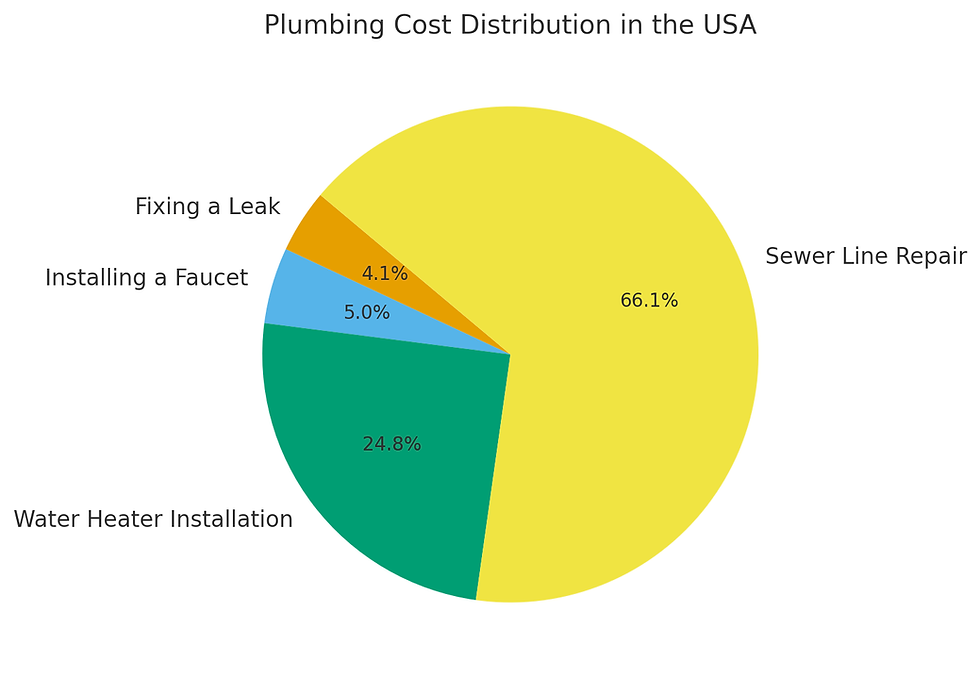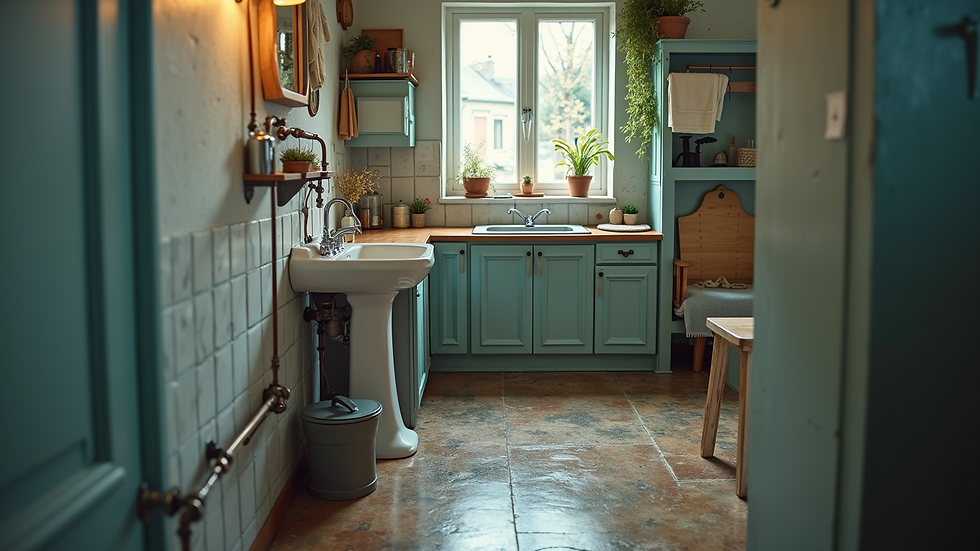Essential Plumbing Tips Every Homeowner Should Know
- Jayant Upadhyay
- Aug 28, 2025
- 8 min read

Plumbing is one of those crucial aspects of home maintenance that often gets overlooked until something goes wrong. Plumbing issues, such as leaky faucets, clogged drains, or malfunctioning toilets, can quickly escalate into more significant problems. For instance, a small drip from a faucet can waste up to 3,000 gallons of water a year. Fortunately, with some knowledge and practical tips, homeowners can tackle many common plumbing problems themselves. In this blog post, we’ll explore essential plumbing tips that every homeowner should know to keep their plumbing systems running smoothly.
Understanding Your Plumbing System
Before diving into specific tips, it’s important to have a basic understanding of your plumbing system. Your home’s plumbing includes a network of pipes, fixtures, and appliances that work together to deliver water and remove waste. Familiarizing yourself with the layout of your plumbing system can help you identify issues more easily.
Knowing where your main water shut-off valve is located is essential. This valve allows you to stop the water supply in case of a significant leak or burst pipe, preventing extensive damage to your home.

Consistent Maintenance is Key
One of the best ways to avoid plumbing disasters is through consistent maintenance. Here are some practical maintenance tips to keep your plumbing secure:
Inspect for Leaks
Regularly check under sinks, around toilets, and near appliances for any signs of leaks. Even a small drip can lead to significant water waste. For instance, small leaks can account for approximately 10 percent of a household’s water use. If you notice any leaks, address them promptly to prevent further issues.
Clean Your Drains
Clogged drains can lead to serious plumbing problems. Prevent clogs by regularly cleaning your drains with a mixture of baking soda and vinegar. Pour down a cup of baking soda followed by a cup of vinegar. After 15 minutes, flush with hot water. This natural solution can help break down buildup, keeping your pipes clear.
Monitor Your Water Pressure
High water pressure can strain your plumbing system and lead to leaks. Use a water pressure gauge to check your home's water pressure. Ideally, it should be between 40 and 60 psi. If the pressure exceeds this range, consider installing a pressure-reducing valve to safeguard your plumbing.
Mastering the Art of Unclogging Drains
Clogs are a common plumbing issue that you can often resolve without calling a plumber. Here are two effective methods for unclogging drains:
Use a Plunger
A plunger is a straightforward yet effective tool for clearing clogs. For toilets, use a flange plunger. For sinks, a cup plunger works best. Create a tight seal around the drain and plunge vigorously for 15 to 30 seconds to dislodge the clog.
Try a Drain Snake
If a plunger doesn’t resolve the issue, a drain snake can reach deeper clogs. Insert the snake into the drain, twisting it gently to break up the blockage. This method can be particularly useful for stubborn clogs caused by hair or grease.


Tackling Common Plumbing Problems
Most homeowners will encounter plumbing issues at some point in their lives, whether they are new to homeownership or have been living in their homes for many years. These plumbing problems can range from minor annoyances to significant issues that require immediate attention. Here are three common plumbing problems that many homeowners face, along with detailed solutions on how to fix them effectively:
Leaky Faucets
A leaky faucet is not only an irritating problem but can also lead to substantial water waste, which impacts both the environment and your water bill. The sound of dripping water can be distracting, and over time, the cumulative effect of a leaky faucet can be quite significant. To address this issue, the first step is to turn off the water supply to the faucet. This is typically done by locating the shut-off valves under the sink and turning them clockwise until they are fully closed.
Next, you will need to disassemble the faucet. Depending on the type of faucet you have—be it a compression, cartridge, ball, or ceramic disk faucet—the disassembly process may vary slightly. Carefully remove any decorative caps and unscrew the handle to access the internal components. Once inside, inspect the washers and O-rings for wear and tear. These small rubber components are often the culprits behind leaks. If they appear cracked, brittle, or misshapen, replace them with new ones that match the size and type of the originals.
After you have replaced the necessary components, reassemble the faucet by reversing the disassembly steps. Ensure that everything is tightened properly, but be cautious not to overtighten, as this can cause damage. Finally, turn the water supply back on and test the faucet for leaks. A dripping faucet can waste about 2,700 gallons of water a year, so taking action promptly is crucial for both conservation and cost-saving purposes.
Running Toilets
A running toilet can be one of the most frustrating plumbing issues, as it can create an incessant sound that disrupts the peace of your home while also being incredibly wasteful. A running toilet can waste more than 100 gallons of water each day, which adds up to a significant amount over time. To troubleshoot this issue, start by removing the toilet tank lid and inspecting the internal components.
The first thing to check is the flapper valve, which is the rubber seal that covers the flush valve opening. Over time, this valve can wear out or become misaligned, leading to continuous water flow from the tank into the bowl. If you notice that the flapper is not sealing properly or is visibly worn, it’s time to replace it. Flapper valves are inexpensive and can be found at most hardware stores.
Additionally, check the float mechanism, which regulates the water level in the tank. If the float is set too high, it will cause the water to overflow into the overflow tube, resulting in a running toilet. Adjust the float arm or the float height according to the manufacturer's instructions to ensure that the water stops at the correct level. Once you have made these adjustments, flush the toilet to see if the problem is resolved. If the toilet continues to run, you may need to consult a plumber for further diagnosis and repair.
Low Water Pressure
If you notice a sudden drop in water pressure, it can be quite concerning, as it may indicate underlying plumbing issues that need to be addressed. Low water pressure can make everyday tasks such as showering, washing dishes, and watering the garden frustrating and inefficient. One common cause of low water pressure is a clogged aerator, which is the screen located at the end of the faucet. Over time, mineral deposits and debris can accumulate in the aerator, restricting water flow.
To resolve this issue, start by removing the aerator from the faucet. Most aerators can be unscrewed by hand, but if it is stuck, you may need to use pliers wrapped in a cloth to avoid scratching the finish. Once removed, soak the aerator in a solution of vinegar and water to dissolve any mineral buildup. After soaking for a while, scrub it with an old toothbrush to remove any remaining debris, then rinse it thoroughly before reattaching it to the faucet.
If cleaning the aerator does not resolve the low water pressure issue, the problem may lie deeper within your plumbing system, such as a leak in the pipes or issues with the municipal water supply. In such cases, it is advisable to consult a professional plumber who can assess the situation and provide the necessary repairs to restore proper water pressure throughout your home.
Knowing When to Seek Professional Help
While many plumbing issues can be handled by homeowners, some situations call for professional help. Here are a few situations when it's wise to call a plumber:
Persistent Clogs
If you’ve attempted multiple methods to unclog a drain with no success, it’s time to call a professional. They have specialized tools and expertise to handle stubborn clogs safely.
Major Leaks
If you discover a major leak or burst pipe, shut off the water supply immediately and call a plumber. Trying to fix a significant leak without professional help can lead to increased damage and costs.
Plumbing Renovations
If you’re planning a major renovation that involves plumbing changes, hire a professional. They can ensure the work is done correctly and complies with local codes.
Preparing Your Plumbing for Winter
As winter approaches, it’s essential to prepare your plumbing for colder temperatures. Here are some strategies to prevent freezing pipes:
Insulate Pipes
Insulating your pipes can help prevent freezing in cold weather. Use foam pipe insulation or heat tape around exposed pipes in unheated areas, such as basements and attics.
Let Faucets Drip
During extremely cold weather, let faucets drip slightly to keep water flowing. This steady trickle can prevent pipes from freezing and bursting.
Maintain Indoor Heat
If you’re going away during winter, keep your home’s heat on at a low temperature. This practice protects your plumbing from freezing issues.
Sustainable Plumbing Practices
Being conscious of your plumbing can also support a more eco-friendly home. By adopting sustainable plumbing practices, you not only enhance the efficiency of your water usage but also contribute positively to the environment. Here are some sustainable plumbing practices that can make a significant difference:
Install Low-Flow Fixtures
One of the most effective ways to conserve water in your home is by installing low-flow faucets and showerheads. These innovative fixtures are designed to reduce water consumption while maintaining excellent performance. By using aerators and advanced technology, low-flow fixtures can significantly cut your water usage, allowing you to save up to 30 percent on your water bill. Additionally, these fixtures come in a variety of styles and finishes, ensuring that you do not have to compromise on aesthetics or functionality in your quest for sustainability. Consider also low-flow toilets, which use less water per flush compared to traditional models, further enhancing your home's water efficiency.
Address Leaks Quickly
As stressed earlier, fixing leaks promptly is crucial for multiple reasons. Not only does it help save water, but it also reduces your utility bills significantly. A small leak can waste gallons of water each day, leading to higher costs and unnecessary water wastage. Moreover, addressing leaks quickly contributes to environmental conservation by ensuring that precious water resources are not squandered. Regularly check your plumbing fixtures, including faucets, toilets, and pipes, for signs of leaks. If you notice any dripping or pooling water, take immediate action to repair the issue. By being proactive about leaks, you not only save money but also play a part in preserving the environment for future generations.
Use Eco-Friendly Drain Cleaners
When it comes to maintaining clean and functional drains, it is essential to choose eco-friendly solutions. Instead of relying on harsh chemicals that can damage your plumbing and harm the environment, consider using natural alternatives like baking soda and vinegar. This combination is not only effective in breaking down clogs and removing odors but is also safe for your pipes and the ecosystem. Regularly using these natural cleaners can help maintain your plumbing system without the negative side effects associated with commercial chemical drain cleaners. Additionally, adopting this practice reduces the risk of introducing toxic substances into the water supply, further promoting a healthier environment.
Final Thoughts
Understanding your plumbing system and knowing how to manage common issues can save you time, money, and frustration. By following these essential plumbing tips, homeowners can maintain their plumbing systems effectively and tackle minor problems before they escalate. Remember, while DIY solutions are great, do not hesitate to call a professional when the situation calls for it. Happy plumbing!




Comments